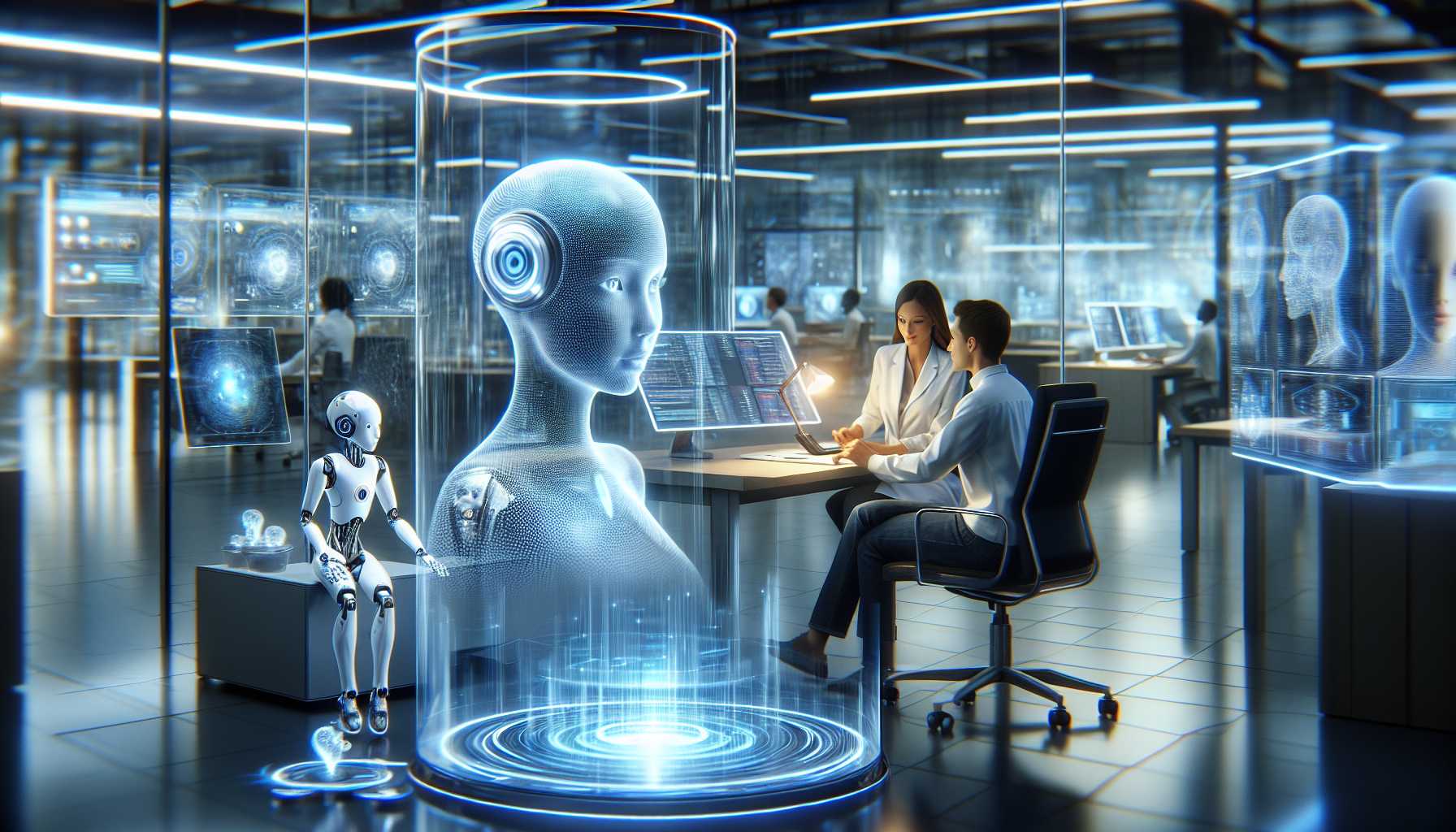 The world of technology is buzzing with the words ‘Artificial Intelligence’ (AI), with large language models like ChatGPT and sophisticated voice synthesis platforms like ElevenLabs drawing significant attention from the media, investors, and the public at large. But as we gaze toward the horizon where AI seems to promise a transformative future, let’s dissect the rhetoric, forecasts, and developments to understand where we truly stand in the AI revolution.
The world of technology is buzzing with the words ‘Artificial Intelligence’ (AI), with large language models like ChatGPT and sophisticated voice synthesis platforms like ElevenLabs drawing significant attention from the media, investors, and the public at large. But as we gaze toward the horizon where AI seems to promise a transformative future, let’s dissect the rhetoric, forecasts, and developments to understand where we truly stand in the AI revolution.
AI in the Workforce: An MIT Perspective on Automation and Jobs
 MIT’s Computer Science and Artificial Intelligence Laboratory (CSAIL) recently embarked on a quest to answer the burning questions around AI’s potential to automate human jobs. While the winds of AI have been long whispering about the transformation of the workforce, MIT’s research offers a refreshing reality check. Previous estimates by industry bigwigs like Goldman Sachs and McKinsey have projected significant automation—up to half of all work being AI-driven by 2055. Nonetheless, MIT’s findings suggest a more slow-paced disruption. The study’s scope, focusing on jobs requiring visual analysis, reveals that just because a job can be automated, doesn’t mean it’s economically viable to do so. Even as we encounter increasingly capable AI systems sold by companies like OpenAI, MIT data suggests that human labor remains irreplaceable in many sectors, at least for now. This doesn’t mean AI won’t affect jobs, but it suggests that this wave may crest more gradually than anticipated—offering us a crucial timeframe for policy development and workforce retraining to adapt to the forthcoming shifts.
MIT’s Computer Science and Artificial Intelligence Laboratory (CSAIL) recently embarked on a quest to answer the burning questions around AI’s potential to automate human jobs. While the winds of AI have been long whispering about the transformation of the workforce, MIT’s research offers a refreshing reality check. Previous estimates by industry bigwigs like Goldman Sachs and McKinsey have projected significant automation—up to half of all work being AI-driven by 2055. Nonetheless, MIT’s findings suggest a more slow-paced disruption. The study’s scope, focusing on jobs requiring visual analysis, reveals that just because a job can be automated, doesn’t mean it’s economically viable to do so. Even as we encounter increasingly capable AI systems sold by companies like OpenAI, MIT data suggests that human labor remains irreplaceable in many sectors, at least for now. This doesn’t mean AI won’t affect jobs, but it suggests that this wave may crest more gradually than anticipated—offering us a crucial timeframe for policy development and workforce retraining to adapt to the forthcoming shifts.
Chronosphere’s Acquisition of Calyptia: A Strategic Move in Cloud Observability
 What does the acquisition of Calyptia by Chronosphere mean for the tech industry? For one, it tells us that there’s an increasing push toward enhancing observability in the cloud-native space—crucial for enterprises dealing with massive inflows of data. Chronosphere, already a notable player in cloud native observability, is set to strengthen its offering by incorporating Calyptia’s expertise in managing observability data pipelines. The amalgamation signifies a trend toward end-to-end platforms that not only address immediate issues but are also geared towards future needs, such as cutting costs and boosting developer productivity. By leaning on the open-source Fluent Ecosystem, Chronosphere showcases a compelling blend of proprietary and community-driven innovation.
What does the acquisition of Calyptia by Chronosphere mean for the tech industry? For one, it tells us that there’s an increasing push toward enhancing observability in the cloud-native space—crucial for enterprises dealing with massive inflows of data. Chronosphere, already a notable player in cloud native observability, is set to strengthen its offering by incorporating Calyptia’s expertise in managing observability data pipelines. The amalgamation signifies a trend toward end-to-end platforms that not only address immediate issues but are also geared towards future needs, such as cutting costs and boosting developer productivity. By leaning on the open-source Fluent Ecosystem, Chronosphere showcases a compelling blend of proprietary and community-driven innovation.
The Resounding Progress of ElevenLabs: Voice Cloning’s Billion-Dollar Valuation
 Voice cloning might sound like an element of futuristic science fiction, but it’s very much a reality—and an incredibly lucrative one at that. ElevenLabs, a startup invested in creating and editing synthetic voices, has swooned the tech industry with its $80 million Series B round. This gargantuan investment catapulting ElevenLabs to a unicorn status underlines the market’s conviction in AI’s capabilities to recreate and personalize human speech. However, excitement intertwines with caution as voice cloning broaches ethical considerations and potential misuse. Indeed, ElevenLabs has come under fire for such reasons—cloned voices have been used in harassment campaigns and to impersonate individuals maliciously. Addressing these challenges, ElevenLabs eyes fortifying safety measures and ethical development, a move that paves the way for responsible tech advancement.
Voice cloning might sound like an element of futuristic science fiction, but it’s very much a reality—and an incredibly lucrative one at that. ElevenLabs, a startup invested in creating and editing synthetic voices, has swooned the tech industry with its $80 million Series B round. This gargantuan investment catapulting ElevenLabs to a unicorn status underlines the market’s conviction in AI’s capabilities to recreate and personalize human speech. However, excitement intertwines with caution as voice cloning broaches ethical considerations and potential misuse. Indeed, ElevenLabs has come under fire for such reasons—cloned voices have been used in harassment campaigns and to impersonate individuals maliciously. Addressing these challenges, ElevenLabs eyes fortifying safety measures and ethical development, a move that paves the way for responsible tech advancement.
NumberEight’s Adverty Partnership: The Surprising Success of In-Game Advertising
 A groundbreaking collaboration between NumberEight and Adverty showcases the power of in-game advertising, an often-overlooked domain within the AI landscape. By leveraging advanced ID-less targeting capabilities of NumberEight’s technology, McDonald’s achieved a 58% increase in brand preference through virtual in-game billboards—a testament to the targeted impact and seamless integration potential of AI in gaming and marketing.
A groundbreaking collaboration between NumberEight and Adverty showcases the power of in-game advertising, an often-overlooked domain within the AI landscape. By leveraging advanced ID-less targeting capabilities of NumberEight’s technology, McDonald’s achieved a 58% increase in brand preference through virtual in-game billboards—a testament to the targeted impact and seamless integration potential of AI in gaming and marketing.
AI Investment: Surfing the Early Waves of a Trillion-dollar Market
 For the financially savvy minds, AI isn’t just about technology—it’s an epoch-making investment frontier. Stocks of companies like Advanced Micro Devices (AMD), Microsoft, and Palantir are more than just ticker symbols; they embody the advent of a new era in blue-chip technology. As AI further entrenches itself in various sectors, the promise of significant returns on AI-centric stocks looms large over this ripe market.
For the financially savvy minds, AI isn’t just about technology—it’s an epoch-making investment frontier. Stocks of companies like Advanced Micro Devices (AMD), Microsoft, and Palantir are more than just ticker symbols; they embody the advent of a new era in blue-chip technology. As AI further entrenches itself in various sectors, the promise of significant returns on AI-centric stocks looms large over this ripe market.
Supermicro vs. Nvidia: The Race to AI Hardware Supremacy
 Nvidia has been the poster child for GPU advancements essential to AI processing. Yet, Super Micro Computer—Supermicro—emerges as a compelling contender. With its stock outpacing Nvidia’s growth and its role as an integral link in the AI hardware chain, Supermicro presents an attractive investment not because it innovates in GPU tech, but because it excels in integrating these GPUs into performance-optimized servers. In light of AI’s growth trajectory, Supermicro epitomizes how tangential industries can flourish alongside core AI technology firms.
Nvidia has been the poster child for GPU advancements essential to AI processing. Yet, Super Micro Computer—Supermicro—emerges as a compelling contender. With its stock outpacing Nvidia’s growth and its role as an integral link in the AI hardware chain, Supermicro presents an attractive investment not because it innovates in GPU tech, but because it excels in integrating these GPUs into performance-optimized servers. In light of AI’s growth trajectory, Supermicro epitomizes how tangential industries can flourish alongside core AI technology firms.
Microsoft: Embedding AI into the Mainstream Fabric
 Generative AI’s promise to revolutionize industries hasn’t escaped the gaze of tech giant Microsoft. By integrating AI into its flagship products and introducing AI-powered Copilot, Microsoft isn’t just dipping its toes in AI waters—it is diving headfirst. Insights into Copilot’s growing popularity amongst Fortune 100 companies underscore the potential for massive incremental gains. It’s exciting to see synaptic connections between Microsoft’s AI innovation and its established services, certainly a rendezvous of contemporary tech with proven enterprise utility.
Generative AI’s promise to revolutionize industries hasn’t escaped the gaze of tech giant Microsoft. By integrating AI into its flagship products and introducing AI-powered Copilot, Microsoft isn’t just dipping its toes in AI waters—it is diving headfirst. Insights into Copilot’s growing popularity amongst Fortune 100 companies underscore the potential for massive incremental gains. It’s exciting to see synaptic connections between Microsoft’s AI innovation and its established services, certainly a rendezvous of contemporary tech with proven enterprise utility.
AI in the Stock Market: What’s the Real Story?
 As AI dominates headlines, investors are counselled to exercise patience. While the AI market is anticipated to be a multi-trillion-dollar industry by the decade’s end, the majority of wealth creation will unfold slowly over time. For those looking to skate to where the puck is going, early investments in AI stocks might be the key to capturing a significant slice of this futuristic market.
As AI dominates headlines, investors are counselled to exercise patience. While the AI market is anticipated to be a multi-trillion-dollar industry by the decade’s end, the majority of wealth creation will unfold slowly over time. For those looking to skate to where the puck is going, early investments in AI stocks might be the key to capturing a significant slice of this futuristic market.
Conclusion: Unveiling the Substance Beyond the AI Hype
Do all these advancements mean AI is at the brink of conquering all technological realms? Not quite, but it does signal a significant pivot toward a future where AI integration becomes the norm rather than the exception. Whether it’s in bolstering cloud infrastructure, personalizing synthetic voices, or weaving through the complex fabric of the stock market, AI’s presence is swelling with tangible impact and promising potential. As AI continues to shape and shake the tech foundation, the only certainty is change. And amidst this change, there is a wealth of opportunity—that, if navigated with insight and ethical foresight, could spell the creation of a more efficient, engaging, and economically sound world. The AI revolution is upon us—you just need to look beyond the hype to see the real transformation unfolding.









